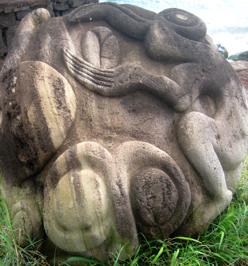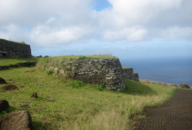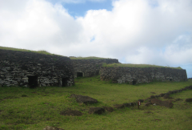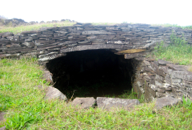ORONGO
CEREMONIAL VILLAGE 1600-1866 A.D.
AT RANO KAU VOLCANO
Rapa Nui, isla de pascua, chile
Easter Island, the pacific ocean
JUNE 13 & 14, 2008


ORONGO
CEREMONIAL VILLAGE 1600-1866 A.D.
AT RANO KAU VOLCANO
Rapa Nui, isla de pascua, chile
Easter Island, the pacific ocean
JUNE 13 & 14, 2008




Before driving out to a point on the southwestern tip of Isla de Pascua, Easter Island, we had learned that Orongo was one of the most important archaeological sites on the island. We had no idea what to expect, yet in our adventurous spirit, I pointed the jeep in the right direction and traversed the bumpy road until we arrived at its end. We were welcomed by the nicest of agents, at the Parque Nacional Rapa Nui, whose name was Carlos. We chatted with him for a while about his illustrious visitors to Orongo (including George Clooney!) then purchased our 5,000 peso ($10 US Dollar) entry tickets, which were good for our whole stay. As requested, we stayed on the trail, to find the stone boat-shaped dwellings which faced the sea. Earth and grass provided insulation and shelter as a roof on these cave-like structures, carefully laid of stone. As we followed the path, we came upon the magical remnants of the volcanic crater of Rano Kau. The rounded shape with sloping edges and a kari-kari or opening, eroded by the ocean waves to reveal the Pacific Ocean. The crater itself was filled with water, and islands of earth and grass, accidentally mimicking a water lily pond. The sky’s reflection tinted the water a dark blue, while the wind blew the feathery grasses to animate the entire scene. It was immediately clear to Henry and me, that this place was special, as it was intentionally sited between the magnificent crater and the charming motus (small islands) just off of the coast in the endless sea. As explained to us in the National Park brochure, Orongo was built as a site for an annual ceremony and contest, held here for a few weeks each spring. This site was the focus of a new religious order, evolving from the megalithic stone heads that signified ancestor worship, to a cult of fertility, centered around the Make-Make god. The 16th century was the transition point between these two periods of devotion. Orongo represents the point of a new organizing principal within the culture of Rapa Nui, where the new order, focus, religious, and political system were solidified. The gradual turn from one order to the next was acted out here beginning in the 16th century, and lasted until the end of the 19th century. Essentially, the site of Orongo was a stage set for an annual ritual contest of the “tangata-manu”. At the beginning of spring each year, chiefs of different tribes, or their hopu (representatives) competed with one anther to obtain the first egg of the manutara or Sooty Tern (Sterna fuscata). This bird arrived every spring to nest on the Motu Nui islet. In anticipation of the bird’s arrival, groups from all over the island traveled to Orongo to prepare for the competition and carried out various celebrations and events. The participants in the contest descended the cliffs overlooking Motu Nui, swam to the larger of the two islets, and camped out to await the arrival of the seabirds. The winner of the contest was the one who successfully found the first egg laid by the Sooty Tern. The wining participant returned to the village of Orongo to be endowed with the title “Tangata-Manu” or “Birdman. If the winning participant represented a chief, then the chief won the title. The new Tangata-Manu was considered “tapu”, or sacred and lived in ceremonial reclusion for one year. The last contest of tangata-manu was held in 1867.
Note: in the Rapa Nui language, the word “mana” means “the force”. It is the supernatural power that animated the function of important daily activities. This power was an attribute of the “Ariki” or “king” who used it to enforce “Tapu” or boundaries/prohibitions. Mana brought prestige to its owner, who used it for the benefit of each family lineage or group. According to Rapa Nui belief, Mana was the factor that secured good harvest, successful fishing, and chicken production.
PHOTOS: Left column: 1. Motu Nui islets as scene from the village of Orongo. 2. The crater of Rano Kau at Orongo. 3. The dug out boat shaped ceremonial houses at Orongo. Events and contests were held in front of these stepped structures each spring. 4. Orongo village houses with a glimpse of the Pacific Ocean, which all the structures faced. Center, Top: Rano Kau crater with its kari-kari and a view of the Pacific Ocean. Center, Bottom: A petroglyph of Tangata-Mana. The photo was taken in Hanga Roa. Though several petroglyphs exist at the Orongo site, this particular carving, with deep etching, best depicts the “Birdman” concept. Right column: 1. Motu Nui islets off the southwest coast of Rapa Nui or Easter Island. 2. A view of the crater of Rano Kau from Orongo’s grasslands. 3. View of the dugout houses and the grass covered ceremonial lawns. 4. View of an entrance to an Orongo village house.

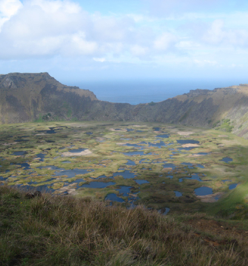
Bird Man Ceremonial Village


